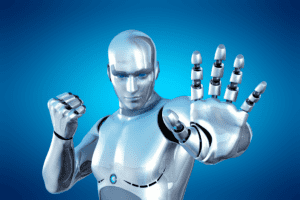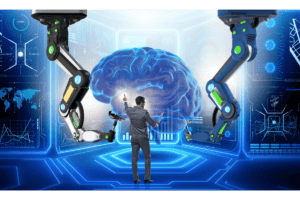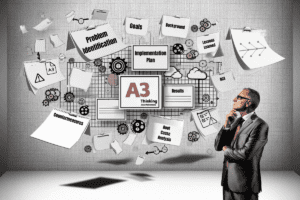Harnessing the Power of AI Cloud Computing: A Transformative Approach for Businesses
The Fusion of AI and Cloud Computing: A game-changing duo
In the ever-evolving realm of technology, certain combinations emerge that transcend the boundaries of innovation. One such formidable alliance is the fusion of AI and cloud computing. The synergy created by harnessing the power of artificial intelligence through robust cloud infrastructure has undeniably become a game-changing force.
As we delve deeper into this dynamic partnership, it becomes increasingly evident that AI’s potential is not fully unleashed without the vast capabilities offered by cloud computing platforms. The agility and scalability provided by these platforms lay a solid foundation for AI’s growth, enabling businesses to embrace cutting-edge technologies without exhausting their resources.
While some may argue that AI can thrive without relying on cloud servers, dismissing the transformative impact of this union would be short-sighted. Many organizations have already recognized the value of integrating AI with their cloud strategy, propelling them ahead in this fast-paced technological race.
The Enigma of Artificial Intelligence: A Brief History and Definition
Artificial Intelligence (AI), the phenomenon that has captivated the minds of scientists, researchers, and dreamers alike, is a concept as elusive as it is intriguing. Defined as the creation of intelligent machines that can perform tasks requiring human intelligence, AI has been a long-standing pursuit in the realm of computer science.
Its roots can be traced back to the 1950s when scientists first began exploring the possibility of creating machines capable of mimicking human cognitive abilities. Although AI has made tremendous strides since its inception, its true potential is yet to be fully realized.
The term “artificial intelligence” encompasses a spectrum of capabilities, ranging from narrow AI designed for specific tasks to general AI capable of performing any intellectual task that a human being can do. Furthermore, there exists an awe-inspiring notion known as superintelligence – an AI system surpassing human intelligence in all aspects.
The Versatility and Impact of AI Across Industries
From Healthcare to Finance, AI’s impact across various industries cannot be overstated.
In healthcare, for instance, machine learning algorithms have revolutionized medical imaging analysis by swiftly analyzing vast datasets with unparalleled accuracy. Moreover, natural language processing (NLP) techniques empower chatbots and virtual assistants to provide personalized patient care and streamline administrative tasks.
The finance industry too has witnessed significant transformations through the integration of AI solutions. Trading algorithms fueled by sophisticated machine learning models now dominate stock markets worldwide.
Additionally, fraud detection systems employ anomaly detection techniques to identify suspicious activities and protect against financial crimes more efficiently than ever before. From transportation and logistics to education and retail, no industry remains untouched by AI’s transformative potential.
Self-driving cars powered by deep neural networks promise enhanced road safety while intelligent tutoring systems tailor educational content according to individual student needs. The possibilities seem limitless, and as AI continues to evolve, its impact will only become more profound.
The Dark Side of AI: Ethical Considerations and Uncharted Territory
While the potential benefits of AI are undeniable, navigating the ethical implications surrounding its development and deployment is becoming increasingly crucial.
As we venture into the realm of superintelligence, we confront uncharted territory fraught with perilous questions. What if AI systems surpass human intellectual capabilities?
Will they remain obedient tools or acquire autonomy? These uncertainties raise concerns about control, accountability, and transparency.
Moreover, biases embedded in training datasets can inadvertently perpetuate social inequalities when applied in real-world scenarios. Privacy concerns also loom large as AI algorithms process staggering amounts of personal data.
Striking a balance between innovation and safeguarding against unintended consequences should be at the forefront of our collective discussions. Artificial intelligence’s journey from theory to reality has been nothing short of remarkable.
Its potential to reshape industries, enhance productivity, and tackle complex challenges is undeniable. However, as we dive deeper into the possibilities it presents – from narrow AI applications to general intelligence and beyond – we must approach this domain with a critical eye towards ethics while fostering responsible development that benefits humanity at large.
Unveiling the Potential of Cloud Computing
Harnessing the Infinite Power of the Digital Realm Cloud computing, often hailed as a technological marvel, has become an essential component driving advancements in artificial intelligence.
To truly understand the potential it holds, we must first grasp its definition and key components. Cloud computing refers to the delivery of on-demand computing resources over the internet, including storage, processing power, and software applications.
It eliminates the need for local servers and infrastructure by leveraging a network of remote servers hosted on the internet. One of the primary benefits cloud computing offers is scalability.
Traditional on-premises infrastructure can only handle a limited capacity, which hampers businesses striving to process and store large volumes of data efficiently. With cloud technology, however, organizations can effortlessly scale their computing resources up or down based on demand.
This scalability enables seamless handling of big data analytics and facilitates highly complex AI algorithms that require significant computational power. Moreover, cost-efficiency plays a prominent role in cloud’s appeal.
Instead of investing heavily in expensive hardware and maintenance costs associated with traditional setups, businesses can opt for pay-as-you-go models offered by cloud service providers. This not only significantly reduces upfront costs but also allows enterprises to allocate their financial resources more effectively towards research and development initiatives.
The Evolutionary Journey: From IaaS to PaaS to SaaS
Advancing Beyond Infrastructure Limitations The evolution of cloud computing has witnessed remarkable strides from its initial stages as Infrastructure-as-a-Service (IaaS) providers to present-day comprehensive platforms providing Software-as-a-Service (SaaS). In its infancy as IaaS, cloud primarily focused on offering virtualized hardware resources accessible remotely via APIs or web interfaces.
This laid a solid foundation for subsequent advancements in Platform-as-a-Service (PaaS), where developers gained access to pre-configured environments to build and deploy applications with ease. Today, the cloud ecosystem has matured into Software-as-a-Service (SaaS), encompassing a multitude of applications managed by someone else while remaining accessible through the internet.
This paradigm shift has empowered businesses, particularly in the AI domain, as they can now leverage sophisticated AI solutions through cloud-based platforms without worrying about technical intricacies. The integration of cloud technology enriches AI development by providing a flexible and easily accessible environment for experimenting with diverse datasets and machine learning algorithms.
Cloud computing has become an indispensable ally in the quest for unlocking the full potential of artificial intelligence. Its scalability, cost-efficiency, and evolving nature from IaaS to PaaS to SaaS have revolutionized how businesses approach AI development.
As we delve deeper into this powerful synergy between AI and cloud computing, we begin to realize that AI is not just a future aspiration; it is an essential driving force behind innovation today. With real-time data processing capabilities offered by the cloud combined with advanced machine learning algorithms, we are poised to witness remarkable transformations across industries in our relentless pursuit of progress.
The Synergy between AI and Cloud Computing
Leveraging cloud infrastructure for AI development and deployment
The marriage of Artificial Intelligence (AI) and Cloud Computing has brought about a paradigm shift in the world of technology. The vast computing power, scalability, and accessibility offered by cloud infrastructure have revolutionized the way AI is developed and deployed.
Gone are the days when AI projects were limited by computational constraints; the cloud has become a catalyst for unleashing the full potential of intelligent machines. By leveraging cloud infrastructure, developers can easily access a large volume of data necessary for training AI models.
Traditional computing resources often fell short in processing massive datasets required to train complex neural networks effectively. However, with the advent of cloud computing, this obstacle is overcome as it provides an abundance of storage capacity to handle vast amounts of data.
Overcoming computational limitations with cloud-based resources
One major advantage that comes with combining AI and cloud computing is overcoming computational limitations. The traditional approach to AI development relied on local hardware resources that were often insufficient when dealing with complex algorithms or deep learning models. This restriction hindered innovation and slowed down progress in various fields where AI could significantly impact society.
However, with the power of the cloud at our disposal, we can now tap into virtually unlimited computational resources on-demand. Whether it’s training machine learning models or running resource-intensive algorithms for real-time decision-making, the cloud provides us with unparalleled capabilities to crunch numbers at lightning speed.
Accelerating training processes through distributed computing
Training an AI model can be a time-consuming endeavor that requires significant computational power. In traditional setups, this process was limited by local hardware capabilities and could take days or even weeks to complete.
However, by utilizing distributed computing through the cloud, we can significantly reduce training times. Distributed computing harnesses multiple machines working in parallel to process data and perform calculations simultaneously.
By utilizing the cloud’s infrastructure, developers can distribute the workload across a network of interconnected servers, accelerating the training process. This not only saves time but also enables faster iterations and experimentation, ultimately enhancing the efficiency of AI development.
Enabling real-time data analysis with cloud-based storage and processing
Real-time data analysis is crucial for many AI applications, ranging from fraud detection to autonomous vehicles. However, performing real-time analytics on massive datasets can be an arduous task for local hardware.
This is where cloud-based storage and processing prove their worth. With cloud computing, organizations can leverage scalable storage solutions that accommodate large volumes of data collected from various sources such as IoT devices or mobile capabilities.
Additionally, by tapping into distributed processing capabilities offered by the cloud, real-time analytics becomes achievable even when dealing with vast amounts of data. The ability to process and analyze incoming data instantaneously facilitates timely decision-making and empowers businesses to gain actionable insights at unprecedented speeds.
The synergy between AI and Cloud Computing has propelled technological advancements to new heights. Leveraging cloud infrastructure for AI development and deployment allows us to overcome computational limitations while benefiting from distributed computing capabilities.
With real-time data analysis becoming feasible through cloud-based storage and processing, we are witnessing a revolution in how we harness the power of AI for innovation across industries. The potential these technologies offer is immense; we must embrace this game-changing combination to drive progress forward in this era of digital transformation.
Applications of AI in Cloud Computing
Smart Virtual Assistants:
Enhancing user experience through natural language processing (NLP) in the cloud In today’s fast-paced digital era, smart virtual assistants have become an indispensable part of our lives.
These AI-powered companions, residing in the cloud, have revolutionized the way we interact with technology. Through advanced NLP techniques, smart virtual assistants can understand and respond to human commands and queries, making our lives easier and more efficient.
By harnessing the power of AI in the cloud, these virtual assistants can comprehend context, extract meaning from spoken or written words, and provide relevant information or perform tasks on our behalf. Whether it’s ordering groceries online or setting reminders for important meetings, these intelligent agents are adept at multitasking while continuously learning and improving their capabilities.
Case study: Amazon Alexa’s integration with AWS Lambda for voice recognition
Amazon Alexa stands as a prime example of how AI solutions can be seamlessly integrated into the cloud infrastructure. Powered by AWS Lambda—a serverless computing service—Alexa utilizes advanced voice recognition algorithms to accurately interpret user commands. With just a simple voice command, users can easily access a wide range of services such as weather updates, music streaming platforms, or even control smart home devices.
The combination of natural language processing in the cloud and deep learning models allows Alexa to understand complex requests with astonishing accuracy. This successful integration between Amazon Alexa and AWS Lambda serves as proof that AI-driven virtual assistants have found their sanctuary within cloud computing services.
Creating personalized experiences using machine learning algorithms in the cloud
Another groundbreaking application of AI in the cloud revolves around creating personalized experiences for users across various platforms. Machine learning algorithms deployed on scalable cloud infrastructures enable companies to process massive amounts of data quickly and efficiently. By analyzing user behavior patterns gathered from interactions with websites, apps, and social media, AI algorithms can offer tailored recommendations, personalized advertisements, and optimized user interfaces.
This level of personalization not only enhances user satisfaction but also drives revenue growth for businesses. For instance, e-commerce giants like Amazon harness the power of machine learning in the cloud to recommend products based on customers’ previous purchases and browsing history.
This intelligent approach not only improves customer engagement but also boosts sales and customer loyalty. These examples illustrate how the synergy between cloud computing and artificial intelligence is transforming our digital experiences.
The integration of AI into the cloud empowers us to interact with technology in a more natural and personalized manner. As we move forward into the future of technology, it is important to recognize the immense potential that lies within combining these two game-changing technologies.
The Future Possibilities of AI Powered Cloud Services
AI-powered Automation at Scale: Revolutionizing Industries through Robotic Process Automation (RPA) on a Global Scale
The exponential growth of AI and machine learning has ushered in a new era of automation, with robotic process automation (RPA) leading the charge. RPA is revolutionizing industries by streamlining repetitive tasks and freeing up human resources to focus on higher-value work.
However, it is the combination of AI and the power of cloud computing that truly unlocks RPA’s potential at scale. In today’s cloud computing age, organizations can leverage the vast computational capabilities of cloud servers to execute complex algorithms that enable intelligent robots to perform intricate tasks.
The sheer volume of data generated by these robots, combined with AI’s ability to analyze and interpret deep insights from this data, paves the way for unprecedented levels of automation. By harnessing the power of cloud-based AI, companies can now deploy armies of intelligent robots across their operations, transforming industries from manufacturing to customer service.
Robots as a Service (RaaS): Deploying Intelligent Robots via the Cloud for Various Tasks
Imagine a world where you can simply access a cloud-based platform and deploy an intelligent robot tailored to your specific needs – welcome to Robots as a Service (RaaS). This innovative concept takes advantage of both AI capabilities and cloud technology enriches AI development. By leveraging powerful algorithms stored in the cloud, RaaS enables organizations to access an array of pre-trained robots ready for deployment across various domains.
With RaaS, businesses no longer need to invest heavily in physical robots or worry about maintenance costs. Instead, they can tap into a pool of diverse robotic solutions readily available in the public cloud.
Whether it’s automating data entry processes or performing complex surgeries in healthcare settings, RaaS offers unparalleled flexibility and scalability. The potential applications are limitless as organizations can now experiment with different robot functionalities without the burden of significant upfront investments.
Cloud Robotics: Collaborative Robots Leveraging Shared Intelligence on the Cloud
In the age of big data, the influence of artificial intelligence is expanding rapidly, and with it, comes a new wave of collaborative robots leveraging shared intelligence on the cloud. Cloud robotics represents a paradigm shift in how robots operate and interact with their environment. By connecting to cloud-based AI systems, robots gain access to massive amounts of structured and unstructured data, enabling them to learn from collective experiences and make more informed decisions.
Cloud-based AI engines provide these intelligent machines with real-time insights that enhance their capabilities, allowing them to adapt swiftly to changing situations. This collaboration between robots and cloud infrastructure fosters a continuous learning loop where each robot’s knowledge benefits others in real-time.
From autonomous vehicles navigating complex traffic scenarios to drones surveying disaster-stricken areas for search-and-rescue missions, cloud robotics revolutionizes the way we perceive intelligent machines. The combination of AI and cloud computing opens up a world of possibilities for automation on an unprecedented scale.
The convergence brings forth innovations such as Robotic Process Automation (RPA), which streamlines industries by automating repetitive tasks through intelligent robots powered by cloud-based AI. With Robots as a Service (RaaS), businesses can deploy customizable robotic solutions via the cloud without substantial investments in physical hardware.
Additionally, cloud robotics introduces collaborative machines that leverage shared intelligence on the cloud, enhancing their ability to learn and adapt in real-time. As we embrace this era of automation-driven by AI and powered by the vast capabilities of cloud computing, industries will undergo transformative changes that will shape our future society profoundly.
Addressing Challenges & Concerns
Security & Privacy: Safeguarding the Intelligent Future
In the midst of our excitement for the union of AI and cloud computing, we must not forget to address the significant concerns surrounding security and privacy. As we embark on this new era of cognitive computing, where vast amounts of sensitive data are being processed and stored in the cloud, it becomes imperative to establish robust security measures to protect this invaluable asset.
Companies need to prioritize data encryption, authentication protocols, and regular security audits to ensure that vital information remains shielded from malicious actors. Furthermore, stringent privacy policies must be enforced by both AI developers and cloud computing providers.
Transparency regarding data usage and consent mechanisms should be implemented to offer users a sense of control over their personal information. Striking a balance between innovation and safeguarding individual privacy is crucial for building trust in AI cloud computing systems.
The Ethical Imperative: Ensuring Fairness in AI Algorithms
As AI becomes deeply integrated into our lives through the utilization of cloud-based technologies, we must also address the ethical implications that arise. One pressing concern is ensuring fairness in AI algorithms. Biases embedded in machine learning models can perpetuate discrimination or reinforce existing social inequalities.
For instance, facial recognition systems trained primarily on certain demographics can lead to biased outcomes. To mitigate these risks, diversifying datasets used for training algorithms is essential.
Additionally, ongoing monitoring and auditing should be conducted to identify any biases within AI applications promptly. Embracing ethical frameworks such as responsible AI development guidelines will aid us in achieving fairness while harnessing the power of intelligent machines.
Conclusion
As we navigate further into the cloud computing age with artificial intelligence as our ally, there are undoubtedly challenges that lie ahead. However daunting they may seem now, these obstacles present opportunities for growth and innovation. By addressing concerns regarding security, privacy, and ethics head-on, we can build a solid foundation for an intelligent future that benefits society as a whole.
The convergence of AI and cloud computing has ushered in a new era of disruption, revolutionizing the way we interact with technology. The potential is limitless when combining data-driven AI algorithms with the vast computing power provided by the cloud.
As we continue to refine our understanding of this powerful duo, let us embrace these new technologies responsibly and thoughtfully, striving to build a future where artificial intelligence and cloud computing work hand in hand to improve our lives and make significant positive impacts on society. The possibilities are boundless, and it is up to us to seize them.
If you liked this article, remember to subscribe to MiamiCloud.com. Connect. Learn. Innovate.









